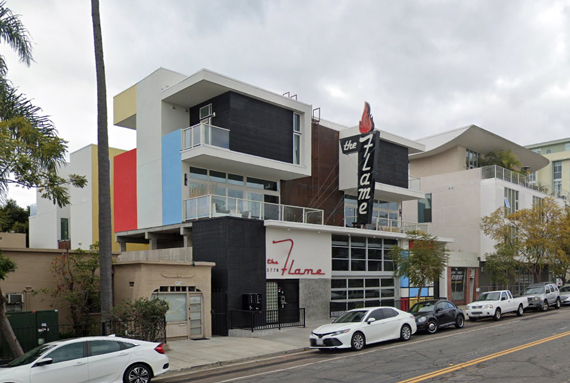|
Opinion: A Hillcrest historic district would honor LGBTQ+ history
A plaque isn't enough
November/December 2021
On October 6, 2021 the San Diego Union-Tribune ran two opinion pieces; both opposed establishing the Hillcrest Historic District with possible additional designation as a LGBTQ+ historic district. Read them both via the following links:
The UT allowed for a response opinion written by Dr. Lillian Faderman, curator of the San Diego History Center's LGBTQ+ exhibit and former Historian-in-Residence at Lambda Archives; Charles Kaminski, architect, historic preservation activist, Lambda Archives board member emeritus, and longtime SOHO member; and Bruce Coons, SOHO's executive director. We share it with you Opinion: A Hillcrest historic district would honor LGBTQ+ history. A plaque isn't enough. and below.
Opinion: A Hillcrest historic district would honor LGBTQ+ history. A plaque isn't enough.
LGBTQ+ history, like the history of other underrepresented communities, has been frequently overlooked. That history has not been considered worthy of consideration or important in the development of our nation and our city. This is because historically, "homosexuals" were deemed criminals and deviants to the law, sinners to the church, mentally ill to the medical profession and often rejected by our own families. But in LGBTQ+ spaces we not only found a home and a new family, we also formed a community that made it possible for us to wage our successful fight for the civil rights due to all Americans.
 The Flame, which opened on Park Blvd. in 1984, was one of the most popular lesbian bars anywhere. Courtesy Google street view |
In San Diego, multiple spaces played a major role in this city's LGBTQ+ civil rights struggle. Many of these sites are located in the Hillcrest area. They have served all of our community—the L, the G, the B, the T, the Q, and the +. Notably, one of the first LGBTQ+ centers in the country began in San Diego in 1973; it has long been housed in Hillcrest. Originally called The Gay Center for Social Services, the center became increasingly important as more people were leaving the closet and especially when the AIDS epidemic overwhelmed our community. The center's early location on Fifth Avenue was a "safe" space for support groups for all races in our community, as well as "coming out" groups, social protest groups, and organizations to assist and give comfort to people with AIDS. The center's continued location in Hillcrest (now on Centre Street) underscores the area's importance to the LGBTQ+ community.
Hillcrest gay bars, too, such as the Brass Rail (which opened in Hillcrest in 1963) and No.1 on Fifth Avenue (opened 1981), served as venues for fundraising and community rallies to generate financial and social support for our sick brothers and sisters as AIDS decimated young lives. They were also crucial venues in which to find entertainment and romance. For instance, the Show Biz Supper Club, which opened on University Avenue in 1968, presented San Diego's first drag show review. The Flame, which opened on Park Blvd. in 1984, was one of the most popular lesbian bars anywhere. Such places were a social "home" when San Diego's LGBTQ+ community had few such places to gather and be ourselves.
That Hillcrest has long been central to San Diego's LGBTQ+ community is also confirmed by anchoring the Pride parades, which started in San Diego in 1974. One of the first Pride parades in the country now attracts hundreds of thousands of people of all ages, marching through the streets of Hillcrest on their way to Balboa Park.
James Nicholas proposes in his opinion piece "Beware District's Impact on Higher Housing Costs" that a plaque would be sufficient to commemorate the significance of Hillcrest to the LGBTQ+ community and the wider world. This modest recognition ignores why many people often travel around the country and to foreign lands and visit historic locations and buildings. Most want to experience that history in person at the place where it happened. The queer spaces of Hillcrest serve as reminders of where we came from and how our LGBTQ+ trailblazers enabled us to become the community we are today. These places serve as inspiration for the future: They help us remember that committed people can and do make a difference in the never-ending struggle for equity and inclusion.
As Nicole Verdes notes in her opinion piece "Making Hillcrest an LGBTQ+ Historic District Concept Has Potential but Also Inherent Risk" the San Francisco Bay Area Transgender District represents a new way of looking at and creating a needed sense of ownership and history. It demonstrates what an historic district can be and how it can support marginalized groups in claiming and writing their own narrative. A Hillcrest LGBTQ+ Historic District can do this, too. As the National Trust for Historic Preservation states: "Historic designation is about history, people, culture, and community understanding."
San Diego's Hillcrest LGBTQ+ community and its allies now have an important opportunity to remember the past, honor our pioneers, recognize and preserve the places and spaces that fostered our visibility, and create a vibrant neighborhood and community for the future. No plaque can convey this rich history nor adequately tell our story. The Hillcrest Historic District is poised to do just that.
|
2025
2024
2023
2022
2021
2020
2019
2018
2017
2016
2015
|




